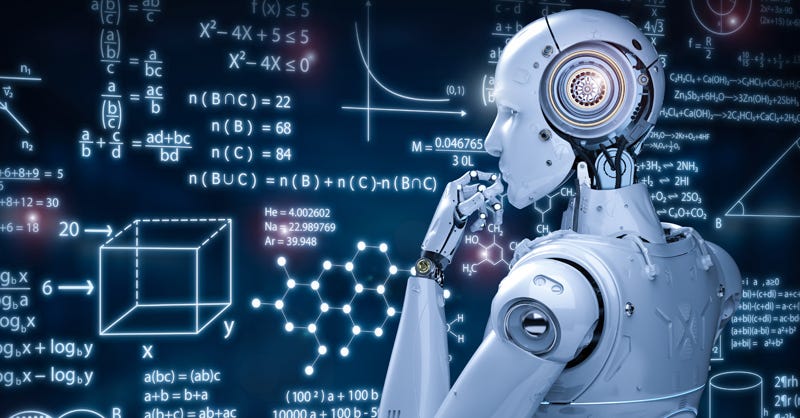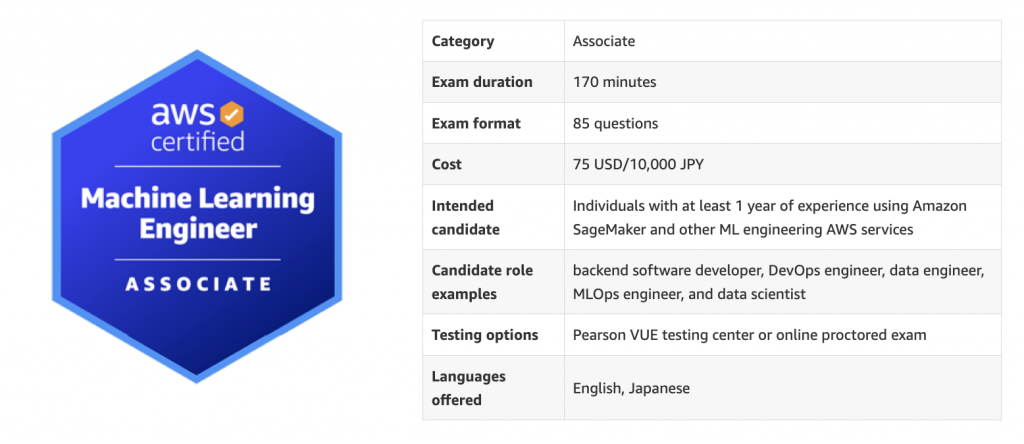All Categories
Featured
Table of Contents
- – How Long Does It Take To Learn “Machine Learni...
- – Our Machine Learning Developer Statements
- – 5 Easy Facts About Machine Learning Developer...
- – What Does How To Become A Machine Learning En...
- – Excitement About How To Become A Machine Lea...
- – Examine This Report about Machine Learning E...
- – The Machine Learning Developer Diaries
Some individuals believe that that's unfaithful. Well, that's my entire career. If somebody else did it, I'm going to use what that person did. The lesson is placing that apart. I'm forcing myself to think through the feasible remedies. It's more about consuming the material and trying to apply those ideas and much less concerning finding a collection that does the job or searching for someone else that coded it.
Dig a little bit deeper in the math at the start, just so I can develop that structure. Santiago: Lastly, lesson number seven. I do not believe that you have to comprehend the nuts and screws of every algorithm before you utilize it.
I have actually been making use of semantic networks for the longest time. I do have a feeling of just how the slope descent functions. I can not describe it to you today. I would certainly have to go and examine back to in fact get a much better instinct. That does not imply that I can not address points using neural networks, right? (29:05) Santiago: Trying to force people to believe "Well, you're not mosting likely to succeed unless you can clarify every single detail of exactly how this functions." It returns to our sorting example I think that's simply bullshit suggestions.
As a designer, I've serviced lots of, several systems and I've made use of several, many points that I do not comprehend the nuts and bolts of how it functions, despite the fact that I recognize the influence that they have. That's the final lesson on that thread. Alexey: The funny point is when I think of all these libraries like Scikit-Learn the formulas they make use of inside to apply, for instance, logistic regression or something else, are not the exact same as the formulas we study in artificial intelligence courses.
How Long Does It Take To Learn “Machine Learning” From A ... Things To Know Before You Buy
Even if we attempted to learn to obtain all these fundamentals of machine understanding, at the end, the formulas that these collections utilize are different. Santiago: Yeah, absolutely. I think we need a whole lot much more materialism in the sector.

Incidentally, there are 2 various courses. I generally talk to those that wish to work in the industry that intend to have their impact there. There is a path for researchers which is entirely different. I do not dare to talk about that because I don't understand.
Yet right there outside, in the sector, pragmatism goes a lengthy way for certain. (32:13) Alexey: We had a comment that stated "Really feels even more like motivational speech than speaking about transitioning." Maybe we must switch. (32:40) Santiago: There you go, yeah. (32:48) Alexey: It is a good motivational speech.
Our Machine Learning Developer Statements
One of the important things I wanted to ask you. I am taking a note to speak about progressing at coding. Initially, allow's cover a pair of points. (32:50) Alexey: Let's begin with core tools and structures that you require to learn to actually change. Let's say I am a software program engineer.
I recognize Java. I recognize SQL. I recognize just how to make use of Git. I know Bash. Perhaps I understand Docker. All these things. And I hear concerning artificial intelligence, it appears like an amazing thing. What are the core devices and frameworks? Yes, I watched this video clip and I obtain convinced that I do not require to obtain deep right into mathematics.
What are the core tools and structures that I need to learn to do this? (33:10) Santiago: Yeah, absolutely. Great concern. I believe, primary, you ought to start finding out a bit of Python. Since you currently understand Java, I don't believe it's mosting likely to be a big shift for you.
Not since Python is the exact same as Java, but in a week, you're gon na obtain a whole lot of the differences there. Santiago: After that you get certain core tools that are going to be made use of throughout your entire career.
5 Easy Facts About Machine Learning Developer Explained
You get SciKit Learn for the collection of device knowing algorithms. Those are devices that you're going to have to be making use of. I do not suggest simply going and discovering regarding them out of the blue.
We can discuss particular training courses later. Take among those programs that are mosting likely to start presenting you to some issues and to some core concepts of equipment learning. Santiago: There is a course in Kaggle which is an intro. I don't keep in mind the name, yet if you most likely to Kaggle, they have tutorials there completely free.
What's great about it is that the only need for you is to recognize Python. They're mosting likely to present a problem and inform you exactly how to make use of decision trees to solve that particular issue. I think that process is extremely powerful, because you go from no maker learning history, to comprehending what the problem is and why you can not solve it with what you know now, which is straight software engineering methods.
What Does How To Become A Machine Learning Engineer [2022] Mean?
On the other hand, ML designers specialize in structure and deploying artificial intelligence designs. They concentrate on training versions with data to make predictions or automate jobs. While there is overlap, AI designers deal with more varied AI applications, while ML designers have a narrower emphasis on artificial intelligence formulas and their useful execution.

Maker knowing designers concentrate on establishing and deploying equipment discovering models right into manufacturing systems. They service engineering, guaranteeing models are scalable, effective, and incorporated into applications. On the other hand, information researchers have a more comprehensive duty that consists of information collection, cleansing, exploration, and structure designs. They are usually in charge of extracting insights and making data-driven choices.
As organizations increasingly adopt AI and equipment discovering innovations, the demand for skilled experts grows. Machine understanding designers work on cutting-edge projects, add to development, and have competitive incomes.
ML is fundamentally different from standard software program advancement as it concentrates on training computers to gain from data, instead of programs specific regulations that are carried out methodically. Unpredictability of end results: You are possibly made use of to composing code with foreseeable outcomes, whether your feature runs as soon as or a thousand times. In ML, however, the end results are much less particular.

Pre-training and fine-tuning: Exactly how these models are educated on vast datasets and then fine-tuned for details jobs. Applications of LLMs: Such as text generation, belief evaluation and details search and retrieval. Documents like "Interest is All You Need" by Vaswani et al., which presented transformers. Online tutorials and programs focusing on NLP and transformers, such as the Hugging Face course on transformers.
Excitement About How To Become A Machine Learning Engineer In 2025
The capability to manage codebases, combine adjustments, and settle problems is simply as crucial in ML development as it is in typical software jobs. The abilities developed in debugging and screening software application applications are highly transferable. While the context might alter from debugging application logic to determining concerns in data processing or design training the underlying principles of systematic examination, theory screening, and iterative refinement are the very same.
Artificial intelligence, at its core, is greatly dependent on stats and chance theory. These are important for recognizing exactly how algorithms pick up from data, make predictions, and evaluate their performance. You ought to consider coming to be comfy with ideas like statistical value, distributions, theory testing, and Bayesian thinking in order to design and translate designs efficiently.
For those thinking about LLMs, a comprehensive understanding of deep knowing architectures is advantageous. This includes not just the mechanics of semantic networks but additionally the architecture of particular designs for different use situations, like CNNs (Convolutional Neural Networks) for image handling and RNNs (Recurrent Neural Networks) and transformers for sequential data and natural language processing.
You need to understand these concerns and discover strategies for determining, mitigating, and communicating about bias in ML designs. This includes the prospective impact of automated decisions and the moral implications. Numerous models, specifically LLMs, require significant computational sources that are commonly provided by cloud systems like AWS, Google Cloud, and Azure.
Structure these skills will certainly not just help with a successful shift into ML yet likewise ensure that developers can add successfully and responsibly to the innovation of this dynamic field. Concept is necessary, however absolutely nothing defeats hands-on experience. Beginning dealing with tasks that enable you to apply what you have actually discovered in a functional context.
Get involved in competitors: Sign up with systems like Kaggle to take part in NLP competitions. Build your projects: Beginning with straightforward applications, such as a chatbot or a message summarization device, and gradually raise intricacy. The field of ML and LLMs is quickly advancing, with brand-new breakthroughs and technologies arising on a regular basis. Staying updated with the most current research study and patterns is crucial.
Examine This Report about Machine Learning Engineer Learning Path
Contribute to open-source tasks or create blog site messages regarding your understanding trip and projects. As you gain know-how, start looking for chances to include ML and LLMs right into your work, or seek brand-new functions focused on these technologies.

Prospective use cases in interactive software application, such as recommendation systems and automated decision-making. Understanding unpredictability, fundamental analytical actions, and probability circulations. Vectors, matrices, and their duty in ML formulas. Error reduction methods and slope descent clarified merely. Terms like version, dataset, features, tags, training, reasoning, and validation. Information collection, preprocessing techniques, model training, analysis procedures, and implementation factors to consider.
Choice Trees and Random Woodlands: Intuitive and interpretable models. Support Vector Machines: Maximum margin category. Matching problem kinds with proper designs. Stabilizing efficiency and complexity. Standard framework of neural networks: neurons, layers, activation functions. Split computation and ahead propagation. Feedforward Networks, Convolutional Neural Networks (CNNs), Recurring Neural Networks (RNNs). Photo acknowledgment, series prediction, and time-series evaluation.
Continual Integration/Continuous Implementation (CI/CD) for ML operations. Version monitoring, versioning, and efficiency tracking. Discovering and dealing with adjustments in version performance over time.
The Machine Learning Developer Diaries
You'll be introduced to 3 of the most appropriate parts of the AI/ML technique; managed understanding, neural networks, and deep learning. You'll grasp the distinctions in between traditional programs and equipment understanding by hands-on development in supervised learning before constructing out complicated distributed applications with neural networks.
This program offers as an overview to equipment lear ... Show More.
Table of Contents
- – How Long Does It Take To Learn “Machine Learni...
- – Our Machine Learning Developer Statements
- – 5 Easy Facts About Machine Learning Developer...
- – What Does How To Become A Machine Learning En...
- – Excitement About How To Become A Machine Lea...
- – Examine This Report about Machine Learning E...
- – The Machine Learning Developer Diaries
Latest Posts
How To Answer “Tell Me About Yourself” In A Software Engineering Interview
How To Ace The Faang Software Engineer Hiring Process From Start To Finish
How To Prepare For A Data Science Interview As A Software Engineer
More
Latest Posts
How To Answer “Tell Me About Yourself” In A Software Engineering Interview
How To Ace The Faang Software Engineer Hiring Process From Start To Finish
How To Prepare For A Data Science Interview As A Software Engineer